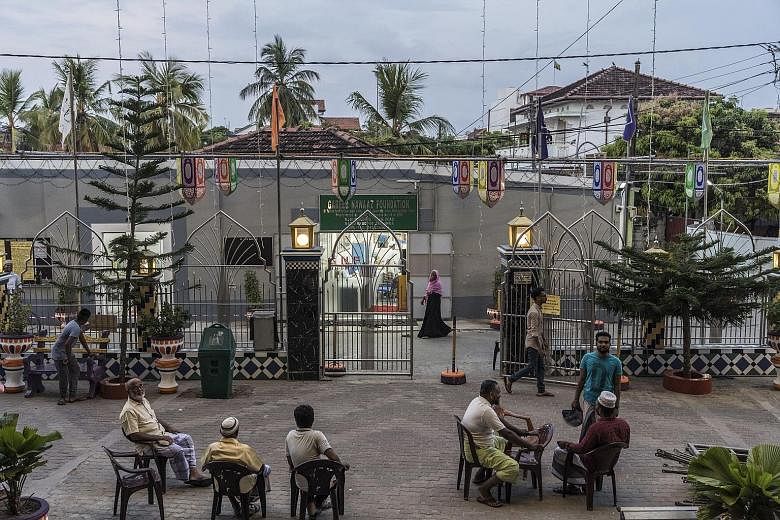KATTANKUDY (Sri Lanka) • When the Wahhabis came, with their austere ideology and abundant coffers, the town of Kattankudy in Sri Lanka yielded fertile ground.
In this part of the country, faith was often the sole sustaining force during the civil war that raged for nearly three decades.
Wahhabism - a hardline strain of Islam blamed for breeding militancy - proposed a direct path to God, albeit one that aimed to return the religion to the time of the Prophet Muhammad.
It was here in Kattankudy's warren of homes decorated with delicate swirls of Arabic calligraphy that Zaharan Hashim, the man accused of masterminding the Easter Sunday attacks in Sri Lanka, grew up. And it was here that he preached his ideology, calling for the killing of non-believers in Islam and even other Muslims.
"To be taken over by radicalism, this is not what we want," said Mr Mohamed Ibraheem Mohamed Jaseem, vice-chairman of the town's urban council. "We are living in Sri Lanka, not a caliphate."
Sri Lankan police say that at least two of the suicide bombers involved in the attacks, which killed at least 250 people, were from Kattankudy. The Islamic State in Iraq and Syria (ISIS) group has claimed responsibility for the attacks.
It was in the 1980s that Kattankudy, one of the few almost exclusively Muslim towns in Buddhist-majority Sri Lanka, began blossoming into a centre of Islamic life. The town was enriched by Saudi money for mosques and madrassas, work-abroad contracts and university scholarships.
But the advent of Wahhabism, with its isolating dogma, has shaken this multi-faith island where minority Muslims have traditionally practised a more inclusive faith. Originating in Saudi Arabia, Wahhabism's stern intolerance denigrates not only those who do not believe in Islam but other Muslim sects as well.
While Saudi Arabia insists the faith does not call for violence, critics have long blamed the kingdom's mass export of its austere creed for fuelling extremism and terrorism abroad. Al-Qaeda leader Osama bin Laden and most of the hijackers in the Sept 11, 2001, attacks were from Saudi Arabia, and ISIS used Saudi religious textbooks inside its self-styled caliphate in Syria and Iraq.
Today in Kattankudy, stately date palms line the main street, as if this lagoon-filled landscape was a desert oasis. Cafes offer tiny cups of syrupy Middle Eastern coffee along with Sri Lanka's famous tea.
There are more than 60 mosques in Kattankudy for a population of 45,000, and most now subscribe to conservative strains of Islam, including Wahhabism.
At the New Kattankudy Grand Jumma Mosque, designed as a replica of Al-Aqsa Mosque in Jerusalem, one of Islam's holiest sites, construction workers are laying blue mosaics as part of the town's mosque-building boom.
"After the age of seven, everyone must pray five times a day, so we always need more mosques," said the mosque's secretary M. I. M. Irfan.
In an appeal to the Muslim community that supported his government, Mr Mahinda Rajapaksa, Sri Lanka's former president and an unabashed Buddhist nationalist, came to lay the cornerstone of the Kattankudy Grand Jumma Mosque. Saudi diplomats visited, too.
Beginning in 2004, Wahhabi-influenced youth from Kattankudy began attacking Sufis, who practise a mystical form of Islam. Hundreds of Sufis were forced from their homes. Zaharan charged with the anti-Sufi brigade. Although Kattankudy's Islamic organisations are horrified by Zaharan's militancy, most have campaigned for years against Sufis.
"Those people, it is not Islam," said Mr M. L. M. Nassar, a member of the Federation of Kattankudy Mosques and Muslim Institutions.
"It's a deviation."
During Sri Lanka's long civil war, which pitted minority Tamils against the Sinhalese majority, Muslims were sometimes caught in the middle. Some Tamils, who are mostly Hindus or Christians, considered Muslims to be government collaborators.
Some Sinhalese, who tend to be Buddhist, distrusted the Muslims in Sri Lanka who speak Tamil and populate some areas where Tamils are clustered.
In 1990, at the height of the terror between insurgents from the Liberation Tigers of Tamil Eelam and the Sri Lankan military, worshippers gathered in the evening for prayer at Kattankudy's Meera Grand Jumma Mosque. Suddenly, gunmen emerged from among the faithful, lobbing grenades. That night, more than 100 people were killed in attacks on two Kattankudy mosques. The perpetrators were believed to have been Tamil Tigers.
NYTIMES


